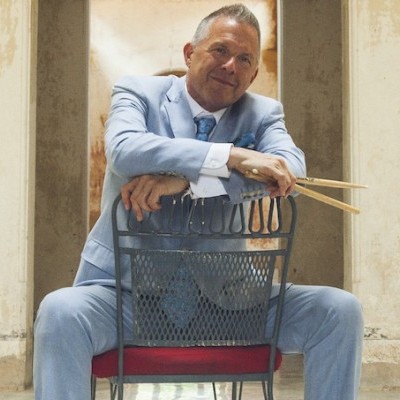Oct 28, 2025 10:47 AM
In Memoriam: Jack DeJohnette, 1942–2025
Jack DeJohnette, a bold and resourceful drummer and NEA Jazz Master who forged a unique vocabulary on the kit over his…
“Chicago—Out Kind of Town” was the theme for college town Ann Arbor, Michigan’s 22nd annual Edgefest, which ran Oct. 16-20. Sixteen concerts—mostly held at the Kerrytown Concert House—plus auxiliary events exposed the power and glory of uncompromising artists associated with the Second City’s past, unbridled present and promising future.
Composer and multi-instrumentalist Roscoe Mitchell served as the festival’s eminence-in-residence. He performed in a troupe dubbed Detroit Friends (guitarist A. Spencer Barefield, saxophonist Skeeter Shelton and pianist Stephen Rush among them), and at the week’s end led a 14-piece-ensemble finale that featured Famoudou Don Moye in the Art Ensemble of Chicago 50th Anniversary Project, which was recorded over four days in a nearby studio for release by Pi Records.
Guitarist Kirsten Carey, a Chicago native and University of Michigan grad whose Uruboros Sextet played her brutalist, rhythm-stiff compositions, shared honors as the youngest bandleader on the program with drummer Adam Shead, of the Tradition Talks trio. But the majority of players were recognized new stars, mid-career Chicago-scene stalwarts or loyal expatriates. Pianist Myra Melford, born and raised in suburban Chicago, and flutist Nicole Mitchell, who established herself professionally while living on the South Side, both currently are professors in California, but still identify with the bluesy freedoms and personalized improvisational directions fostered by the city that gave birth to AACM.
Many enduringly influential artists emerged from the the collective’s late ’60s/early ’70s efforts to encourage originality, individuality and entrepreneurship; at Edgefest the Artifacts Trio—flutist Mitchell (sometimes using effects, doubling on piccolo), cellist Tomeka Reid and drummer Mike Reed—performed affecting songs by two of them, the prodigious Anthony Braxton and late drummer Steve McCall, best known for his membership in the trio Air. Artifacts’ close and quickly interactive, melodically-based music was similar in effect, if slightly different in approach to that of the Tiger Trio—flutist Mitchell with Melford and French bassist Jöelle Léandre.
Whereas Artifacts is eager to reform the canon of standards, Tiger Trio took turns launching fully improvised pieces with a sound or gesture that instantly would be taken up, responded to or countered, expanded upon, digressed from and sometimes returned to. Léandre had performed solo the day before, treating her bass almost as a recalcitrant, human partner with an imaginatively broad array of touches, slaps and bowings. Melford had a solo recital prior to the Tiger Trio show as well. In the trio, all three employed extended techniques. Mitchell’s bountiful, lissome lines flew over and dove into the ever-changing textures Melford and Léandre stirred up, and all moved together with palpable delight.
Improvising tightly as a unit clearly enabled musicians at Edgefest to attain energized heights—some roaring rage, but some expressing ecstasy. An aggressive, probing sound on reeds has been a Chicago staple going back to the 1930s, and here it was exemplified by Ed Wilkerson, Jason Stein, Tim Haldeman and Dave Rempis, perhaps the rawest of the group. Power-drumming is a Chicago hallmark, too; Chad Taylor (with Stein and Jaimie Branch) and Avreeayl Ra (with Harrison Bankhead and Rempis) have contrasting manners, but both utilized notable speed and strength. The city also gained renown as a piano town in the wake of Jelly Roll Morton and Earl “Fatha” Hines—besides Melford, Jim Baker on ARP synthesizer, as well as piano, with both Bankhead’s and Rempis’ bands added depth. And Paul Giallorenzo used electronics to enhance Stein’s motifs.
Jazz-related strings are another Chicago tradition, and Roscoe Mitchell’s Art Ensemble project—presented at the Bethlehem United Church of Christ—employed cellist Reid, violinist Jean Cook, violaist Eddy Kwon and bassists Silvia Bolognesi, Jaribu Shahid and Junius Paul. Those six balanced percussion provided by Moye (traps and djembe), Titos Sompa (congas and mbira) and Enoch Williamson (African drums), the brass of Hugh Ragin and Fred Berry, and Christina Wheeler’s voice and processed Theremin. Amid it all, Nicole Mitchell’s flute complemented Roscoe Mitchell’s blasts on sopranino, and his one calm chorus on “Odwalla.” That tune was the sole direct reference to the Art Ensemble’s oeuvre, and it was a welcome reminder that what comes out of Chicago eventually is embraced worldwide.
Edgefest has devout followers—a capacity crowd of about 100 people attended show after show, and several patrons sponsored specific acts. But the community has outreach, too. On Saturday morning, saxophonist Andrew Bishop led high school students with horns and a bevy of followers on a march through the local farmers’ market, during which they blew a ragtag version of John Coltrane’s “A Love Supreme.” DB

Jack DeJohnette boasted a musical resume that was as long as it was fearsome.
Oct 28, 2025 10:47 AM
Jack DeJohnette, a bold and resourceful drummer and NEA Jazz Master who forged a unique vocabulary on the kit over his…

Always a sharp dresser, Farnsworth wears a pocket square given to him by trumpeter Art Farmer. “You need to look good if you want to hang around me,” Farmer told him.
Sep 23, 2025 11:12 AM
When he was 12 years old, the hard-swinging veteran drummer Joe Farnsworth had a fateful encounter with his idol Max…

D’Angelo achieved commercial and critical success experimenting with a fusion of jazz, funk, soul, R&B and hip-hop.
Oct 14, 2025 1:47 PM
D’Angelo, a Grammy-winning R&B and neo-soul singer, guitarist and pianist who exerted a profound influence on 21st…

Kandace Springs channeled Shirley Horn’s deliberate phrasing and sublime self-accompaniment during her set at this year’s Pittsburgh International Jazz Festival.
Sep 30, 2025 12:28 PM
Janis Burley, the Pittsburgh International Jazz Festival’s founder and artistic director, did not, as might be…

Jim McNeely’s singular body of work had a profound and lasting influence on many of today’s top jazz composers in the U.S. and in Europe.
Oct 7, 2025 3:40 PM
Pianist Jim McNeely, one of the most distinguished large ensemble jazz composers of his generation, died Sept. 26 at…